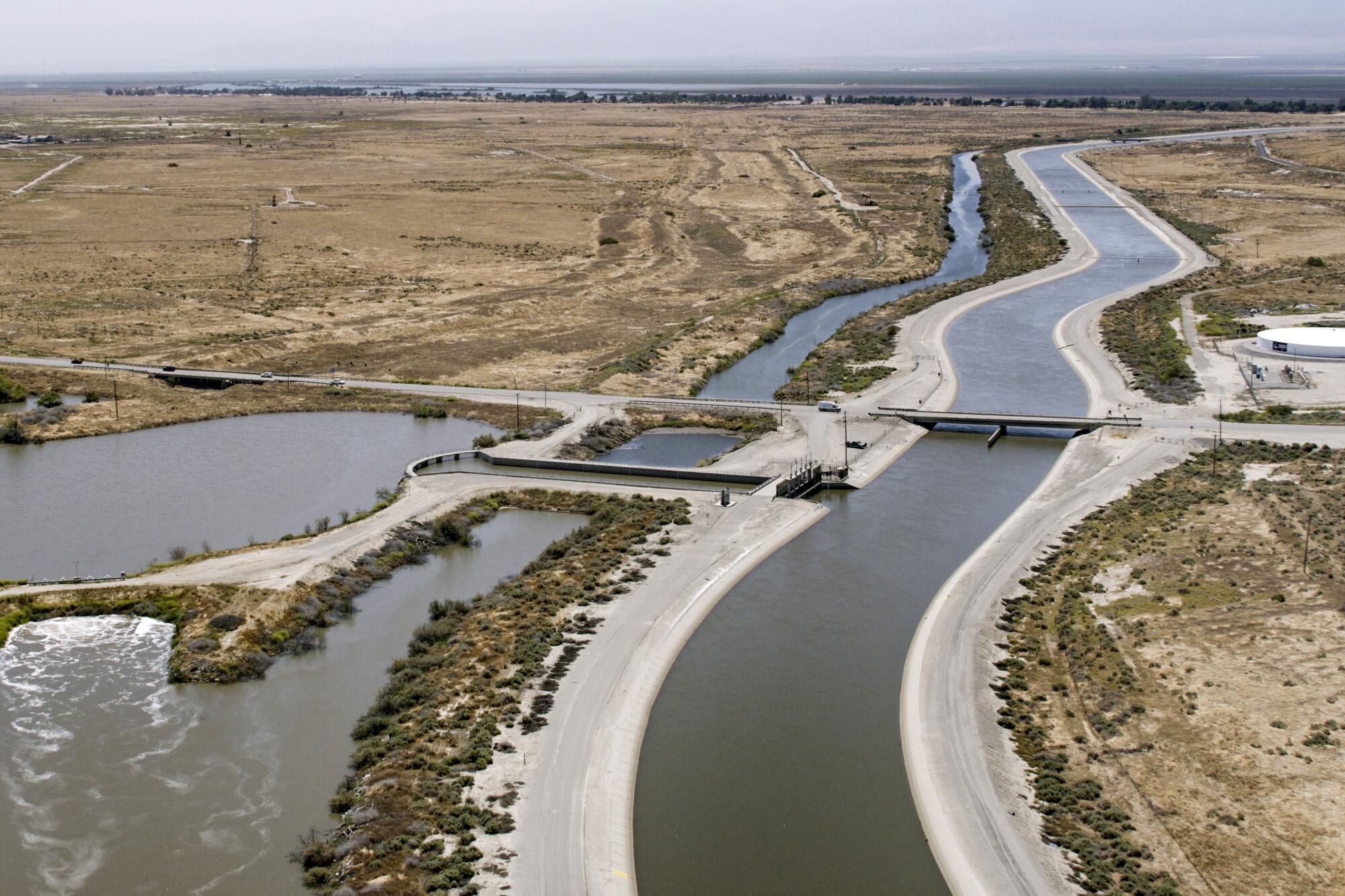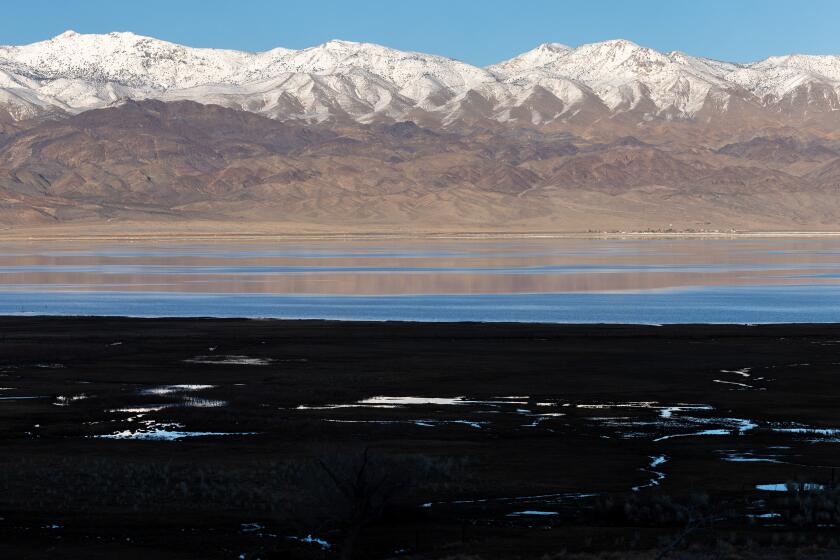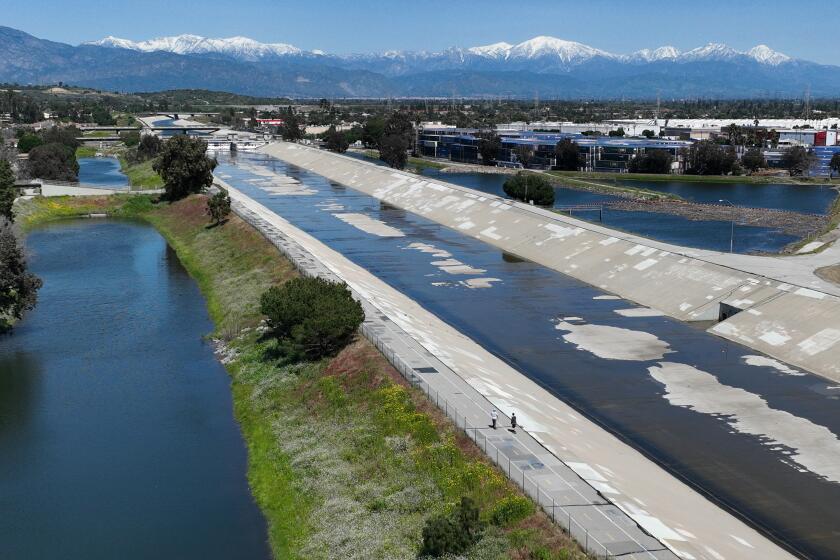
- Share via
On the heels of a soaking start to 2024, state water managers on Friday announced a considerable increase in their forecasted water allocation for the year.
The California Department of Water Resources said it expects to provide 30% of requested supplies from the State Water Project, a massive network of reservoirs, canals and dams that supplies 29 water agencies serving about 27 million people.
The increase is double the initial projection issued in February of 15%.
Aggressive and impactful reporting on climate change, the environment, health and science.
The federal Central Valley Project — a similar network that serves as a key source of water for agricultural users in the state — also announced an increase on Friday. The increase includes 100% of its contractual allotments for agricultural users north of the Sacramento-San Joaquin River Delta, and 35% of allotments for irrigators south of the delta, up from 75% and 15%, respectively.
“Mid- to late February storms have since improved hydrological conditions particularly for Northern California, allowing for a more robust water supply allocation,” the agency said in a statement.
Storms in February have significantly boosted California’s snowpack, giving the state near-average conditions and ample water supplies.
Indeed, both upgrades were attributed to soaking storms that dumped record rainfall and blinding blizzards across large swaths of California. Statewide snowpack on Friday was 98% of its average for the date, while the state’s major reservoirs were at 116% of their historic levels.
The next possible allocation update from the State Water Project would come after the fourth snow survey of the season on April 1. Should the current allocation hold, it would mark a significant improvement from the string of drought years ending in 2022, when state allocations were slashed to just 5%, spurring unprecedented water restrictions in Southern California.
But it would also be a considerable decrease from 2023, when water managers provided 100% of requested supplies for the first time in nearly 20 years after a remarkably wet winter.
Such rapid swings — not just in weather but in water reliability — are reflective of the state’s changing climate, officials say. The long-term trend points to hotter, drier conditions driven by climate change that will be punctuated by bursts of extreme weather, a pattern sometimes referred to as “weather whiplash.”
“As we experience more extreme weather conditions, each year brings its own challenges and that’s why it’s so critical to continue to adapt our water system to build climate resilience,” read a statement from DWR director Karla Nemeth.
When it comes to stormwater capture, California stands out for “untapped potential,” according to the Pacific Institute.
State water officials said they have spent the winter working to maximize the capture and storage of water from this year’s winter storms, adding about 630,000 acre-feet to Lake Oroville and 150,000 acre-feet to the San Luis Reservoir since Jan. 1. (An acre-foot is approximately 326,000 gallons, or enough water to supply up to three homes for a year.)
But the state has also been criticized for missing out on opportunities to capture more stormwater and to recharge aquifers that have been drained by agriculture and drought. A recent report from the Pacific Institute determined that California ranks ninth of the 10 U.S. states with the most “untapped potential,” with approximately 2.27 million acre-feet of urban area runoff washing down storm drains and running to the ocean each year.
Not all of that water is capturable, and some is needed for environmental purposes, recreation and other uses, but the sheer volume indicates that more could be done, the researchers said.
State and federal officials said they were also hampered this winter in their ability to move water south through the system due to the presence of threatened and endangered fish species near pumping facilities in the south delta.
The presence of the fish — including delta smelt, winter-run chinook salmon and steelhead trout — has triggered state and federal permit requirements that significantly reduce pumping from the delta, including limiting the ability to move water into the San Luis Reservoir, officials said.
“While the series of storms in Northern California improved the water supply outlook, a number of factors, particularly anticipated regulatory constraints throughout the spring, continue to limit the water supply allocation for south-of-delta agriculture,” said Karl Stock, regional director for the Bureau of Reclamation, which oversees the Central Valley Project.
Nemeth said similarly that “DWR continues to take proactive measures and use the best available science to operate our water storage and delivery system to balance water supply needs while protecting native fish species.”
Environmentalists are calling for federal intervention after 4,000 threatened fish were killed by pumps operated by the State Water Project and the Central Valley Project.
She underscored the need for climate adaptation efforts, including the advancement of the Delta Conveyance Project, a proposed 45-mile tunnel that would move more water from the delta to regions to the south.
A subject of fierce opposition, the $16-billion project “will make it possible to move more water during high flow events while helping fish species like steelhead trout avoid threats posed by current pumping infrastructure,” the DWR said.
Had the tunnel been in place this winter, the DWR could have captured an additional 730,000 acre-feet of water between Jan. 1 and March 14, or enough for more than 7.6 million people for a year, according to Jennifer Pierre, general manager of the State Water Contractors, a nonprofit association of public water agencies.
“California’s climate is rapidly changing, and we must modernize our infrastructure so we can respond quickly to take advantage of unpredictable, flashy storm events and store as much water as possible for the next inevitable dry period,” Pierre said in a statement. “With rain and snow in this weekend’s forecast, we hope to see an increase in the April allocation update.”
The DWR said it is also working with state, federal and local partners to continue to invest in groundwater recharge projects, surface water storage such as Sites Reservoir, and the expansion of stormwater capture and desalination projects.
The State Water Project allocation announced Friday includes the anticipated delivery of 30% of requested supplies to contractors south of the delta — which account for the majority of contractors — as well as 50% to contractors north of the delta and 100% to Feather River Settlement Contractors, the DWR said.
The final allocation for the year is typically determined in May or June.
The Delta Conveyance Project is a key component of Gov. Gavin Newsom’s strategy for a hotter, drier California. Opponents say it will be an ecological disaster.














